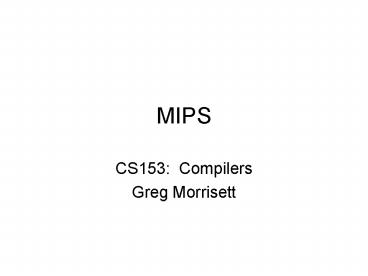MIPS - PowerPoint PPT Presentation
1 / 19
Title:
MIPS
Description:
Your task: build lexer and parser. using ML-Lex and Yacc. Today: Quick overview of the MIPS instruction set. We're going to be compiling to MIPS assembly language. ... – PowerPoint PPT presentation
Number of Views:55
Avg rating:3.0/5.0
Title: MIPS
1
MIPS
- CS153 Compilers
- Greg Morrisett
2
Notes
- Problem Set 1 due Friday before class
- SML exercises
- MIPS interpreter
- Problems? Email Gregory or me.
- Problem Set 2 coming soon
- Given AST for a small, Fortran-like language
- expressions statements only
- Your task build lexer and parser
- using ML-Lex and Yacc
3
Today
- Quick overview of the MIPS instruction set.
- We're going to be compiling to MIPS assembly
language. - So you need to know how to program at the MIPS
level. - Helps to have a bit of architecture background to
understand why MIPS assembly is the way it is. - There's an online manual that describes things in
gory detail.
4
MIPS
- Reduced Instruction Set Computer (RISC)
- Load/store architecture
- All operands are either registers or constants
- All instructions same size (4 bytes) and aligned
on 4-byte boundary. - Simple, orthogonal instructions
- e.g., no subi, (addi and negate value)
- All registers (except 0) can be used in all
instructions. - Reading 0 always returns the value 0
- Easy to make fast pipeline, superscalar
5
x86
- Complex Instruction Set Computer (CISC)
- Instructions can operate on memory values
- e.g., add eax,ebx
- Complex, multi-cycle instructions
- e.g., string-copy, call
- Many ways to do the same thing
- e.g., add eax,1 inc eax, sub eax,-1
- Instructions are variable-length (1-10 bytes)
- Registers are not orthogonal
- Hard to make fast(but they do anyway)
6
Tradeoffs
- x86 (as opposed to MIPS)
- Lots of existing software.
- Harder to decode (i.e., parse).
- Harder to assemble/compile to.
- Code can be more compact (3 bytes on avg.)
- I-cache is more effective
- Easier to add new instructions.
- Todays implementations have the best of both
- Intel AMD chips suck in x86 instructions and
compiles them to micro-ops, caching the
results. - Core execution engine more like MIPS.
7
MIPS instructions
- Arithmetic logical instructions
- add, sub, and, or, sll, srl, sra,
- Register and immediate forms
- add rd, rs, rt
- addi rd, rs, lt16-bit-immedgt
- Any registers (except 0 returns 0)
- Also a distinction between overflow and
no-overflow (well ignore for now.)
8
Encodings
add rd, rs, rt
- Op16 rs5 rt5 rd5 05
Op26
addi rt, rs, ltimmgt
Op16 rs5 rt5 imm16
9
Movement
- Assembler provides pseudo-instructions
- move rd, rs ? or rd, rs, 0
- li rd, lt32-bit-immgt ? lui rd,
lthi-16-bitsgt ori rd, rd, ltlo-16-bitsgt
10
MIPS instructions
- Multiply and Divide
- Use two special registers mflo, mfhi
- i.e., mul 3, 5 produces a 64-bit value
which is placed in mfhi and mflo. - Instructions to move values from mflo/hi to the
general purpose registers r and back. - Assembler provides pseudo-instructions
- mult 2, 3, 5 expands into
- mul 3,5
- mflo 2
11
MIPS instructions
- Load/store
- lw rd, ltimmgt(rs) rd Memrsimm
- sw rs, ltimmgt(rt) Memrtimm rs
- Traps (fails) if rsimm is not word-aligned.
- Other instructions to load bytes and half-words.
12
Conditional Branching
- beq rs,rt,ltimm16gt if rs rt then pc
pc imm16 - bne rs,rt, ltimm16gt
- b ltimm16gt beq 0,0, ltimm16gt
- bgez rs, ltimm16gt if rs gt 0 then pc pc
imm16 - Also bgtz, blez, bltz
- Pseudo instructions bltcompgt rs,rt, ltimm16gt
13
In Practice
- Assembler lets us use symbolic labels instead of
having to calculate the offsets. - Just as in BASIC, you put a label on an
instruction and then can branch to it - LOOP
- bne 3, 2, LOOP
- Assembler figures out actual offsets.
14
Tests
- slt rd, rs, rt rd (rs lt
rt) - slt rd, rs, ltimm16gt
- Additionally sltu, sltiu
- Assembler provides pseudo-instructions for seq,
sge, sgeu, sgt, sne,
15
Unconditional Jumps
- j ltimm26gt pc (imm26 ltlt 2)
- jr rs pc rs
- jal ltimm26gt 31 pc4
pc (imm26 ltlt 2) - Also, jalr and a few others.
- Again, in practice, we use labelsfact
- main jal fact
16
Other Kinds of Instructions
- Floating-point (separate registers fi)
- Traps
- OS-trickery
17
An Example
- int sum(int n) sum ori 2,0,0
- int s 0 b test
- for ( n ! 0 n--) loop add 2,2,4
- s n subi 4,4,1
- test bne 4,0,loop
- j 31
- int main() main ori 4,0,42
- return sum(42) move 17,31
- jal sum jr 17
18
Better
- int sum(int n) sum ori 2,0,0
- int s 0 b test
- for ( n ! 0 n--) loop add 2,2,4
- s n subi 4,4,1
- test bne 4,0,loop
- j 31
- int main() main ori 4,0,42
- return sum(42) j sum
19
One Final Point
- We're going to program to the MIPS virtual
machine which is provided by the assembler. - lets us use macro instructions, labels, etc.
- (but we must leave a scratch register for the
assembler to do its work.) - lets us ignore delay slots.
- (but then we pay the price of not scheduling
those slots.)































